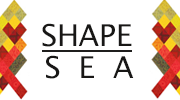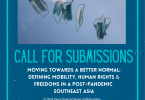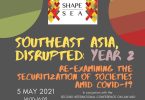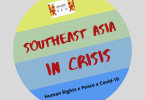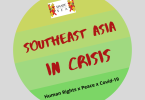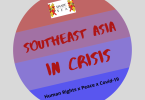Arif R. HaryonoStudent, Asia Pacific MA Human Rights and DemocratisationGlobal Campus of Human Rights Asia PacificInstitute of Human Rights and Peace Studies, Mahidol University
 Indonesia is well-known for its hospitality and harmonious community despite its multi-cultural and ethnic background. The nation ™s motto of Bhinneka Tunggal Ika or Unity in Diversity has acted as the backbone of social cohesion to the diverse communities. However, the recent surge of COVID-19 has hit the nation’s motto and might torment the country’s harmony. The effect is so massive to the extent it has caused negative stigmatization and marginalization against those related to COVID-19: the patients, the medical officers, and their families.What makes this negative stigma and marginalization emerge in the country known for its gotong royong (mutual help) principle?From the writer ™s perspective, the phenomenon of stigma and marginalization finds its trajectory as ignorance and fear grow hand in hand with the spread of COVID-19. As the whole of Indonesia’s media and channels of information is crowded with COVID-19 — not to mention the circulation of COVID-19 misinformation — and its effects on the infected patients, the people started to build psychological and social barriers as defensive mechanisms to protect them and their families. This barrier brings about prejudice against the infected people and those closely related to the virus. Sylvie Brand (Ren, Gao, Chen, 2020, p. 653) from the World Health Organization has warned that “fear and stigma go together and when people fear, they tend to stigmatize some groups “. Thus Brand further emphasizes the need for states to protect the people from the Coronavirus and its social impacts.Indonesian media report several cases of stigmatization and marginalization towards certain groups of communities. In several areas in Indonesia, the dead bodies of medical officers were rejected from being buried in local cemeteries, as the corpses were stigmatized as a primary source of COVID-19 ™s infection (Azanella, 2020). The community is also shunning some members of families of medical officers who treat COVID-19 patients. This social exclusion includes the children of medical officers who are not allowed to play with their friends (Astuti and Syaefullah, 2020). If this condition continues, the child’s development might be disrupted by psychological disorders such as stress or trauma. Two particular cases of religious congregations being disbanded by the communities took place in several regions of Indonesia (Rafie, 2020; Lova, 2020), as the people were accusing them of bringing the infection to their area. In the presence of unfortunate incidents, the stigmatization towards certain groups might lead towards a series of past horizontal conflicts if none of the preemptive actions is taken.To avoid further incidents in other areas, the writer believes that it is important to understand the basic concepts of stigma and marginalization. In the 17th century, stigma was considered as “branding or marking individuals, especially criminals. who were no longer ˜full ™ members of society and whose presence should be suspected” (Dovi, 2001, p. 103). Stigmatization can also be manifest through physical appearance (Brouwer, 1998, p. 117) such as labeling, stereotyping, and devaluating by and of the stakeholders (Mirabito, et.al. 2016, p. 171). In short, stigmatization is exclusion by discrediting an individual (or group of individuals) from the community. Cases of stigmatization also showed patterns of excluding individuals or groups who are perceived as distinct from the community.As we look deeply into the global historical archives, cases of stigma also appeared during pandemic cases. The syphilis pandemic that occurred in Europe in the fifteenth century was named differently in many countries by labeling the disease after their opposition counterpart, such as the Morbus Germanicus by the people of Paris, the French pox by the English, and the Naples sickness by the Florentines (Ren, Gao, Chen, 2020, p. 654). During the SARS crisis, incidents involving racially-based action towards the Chinese-Canadians and other Asian migrant communities had taken place in Toronto, Canada (Ali, 2008, p. 52). Although incidents of attacking people of Chinese descent during the coronavirus pandemic has not yet taken place in Indonesia, many cases of racial attack and verbal abuse towards the Asian community have been reported by the media worldwide.In conclusion, overcoming a disease might be the responsibility of the medical workers, but managing a worldwide pandemic and its impacts is a matter of state policy. As stigmatization and marginalization grow from fear and ignorance, it is important for the government to conduct massive and systematic information disbursement related to COVID-19. For that reason, the state must collaborate with all of the stakeholders to overcome the challenge of stigma by providing the people with reliable and accountable information, using assertive policies to manage the pandemic, relieving the public’s worries by providing information hotlines or psychological treatment centers, and promoting the transparency of actions to avoid any misinformation of the pandemic. The state must avoid the further social implications of the COVID-19 outbreak, for it may last longer than the pandemic itself. So sad but true.References:Ali, S.H., 2008. Stigmatized Ethnicity, Public Health, and Globalization. Canadian Ethnic Studies, 40(3), p.43-64. . Available at: <https://doi.org/10.1353/ces.2008.0002> .Azanella, L.A., 2020. Penolakan Jenazah Pasien COVID-19, Mengapa Bisa Terjadi?. Kompas.com . Available at: <https://www.kompas.com/tren/read/2020/04/13/110821765/penolakan-jenazah-pasien-covid-19-mengapa-bisa-terjadi> .Astuti, L.D.P., Syaefullah, 2020. Duka Perawat COVID-19, Keluarganya Dijauhi Tetangga. Viva.com . Available at: <https://www.viva.co.id/berita/nasional/1211806-duka-perawat-pasien-covid-19-keluarganya-dijauhi-tetangga> .Brouwer, D., 1998. The Precarious Visibility Politics of Self-Stigmatization: The Case of HIV/AIDS Tattoos. Text and Performance Quarterly, 18(2) p. 114-136 . Available at: <https://doi.org/10.1080/10462939809366216> .Dovi, S., 2001. Evil Enemies: Stigmatizing Our Opponents or Legitimizing Our Wars?. Peace Research 33(1) p.101-112 . Available at: <https://www.jstor.org/stable/23607789> .Lova, C., 2020. Ibadah di Rumah Saat PSBB Dibubarkan Tetangga, Polisi Bilang Itu Karena Salah Paham. Kompas.com . Available at: <https://megapolitan.kompas.com/read/2020/04/20/10213331/ibadah-di-rumah-saat-psbb-dibubarkan-tetangga-polisi-bilang-itu-karena> .Mirabito, A.M., et.al. 2016. The Stigma Turbine: A Theoretical Framework for Conceptualizing and Contextualizing Marketplace Stigma. Journal of Public Policy and Marketing, 35(2), p. 170-184. Available at: <https://www.jstor.org/stable/44164850> .Rafie, B.T. (ed), 2020. Jadi Sorotan: Abaikan Corona, Ribuan Muslim Asia Hadiri Tabligh Akbar di Sulsel. Kontan.co.id . Available at: <https://internasional.kontan.co.id/news/jadi-sorotan-abaikan-corona-ribuan-muslim-asia-hadiri-tabligh-akbar-di-sulsel?page=all> .Ren, S., Gao, R., Chen, Y., 2020. Fear Can Be More Harmful Than The Severe Acute Respiratory Syndrome Coronavirus 2 In Controlling The Corona Virus Disease 2019 Epidemic. World Journal of Clinical Cases, 8(4), p. 652-657. Available at: <https://dx.doi.org/10.12998/wjcc.v8.i4.652> .
Indonesia is well-known for its hospitality and harmonious community despite its multi-cultural and ethnic background. The nation ™s motto of Bhinneka Tunggal Ika or Unity in Diversity has acted as the backbone of social cohesion to the diverse communities. However, the recent surge of COVID-19 has hit the nation’s motto and might torment the country’s harmony. The effect is so massive to the extent it has caused negative stigmatization and marginalization against those related to COVID-19: the patients, the medical officers, and their families.What makes this negative stigma and marginalization emerge in the country known for its gotong royong (mutual help) principle?From the writer ™s perspective, the phenomenon of stigma and marginalization finds its trajectory as ignorance and fear grow hand in hand with the spread of COVID-19. As the whole of Indonesia’s media and channels of information is crowded with COVID-19 — not to mention the circulation of COVID-19 misinformation — and its effects on the infected patients, the people started to build psychological and social barriers as defensive mechanisms to protect them and their families. This barrier brings about prejudice against the infected people and those closely related to the virus. Sylvie Brand (Ren, Gao, Chen, 2020, p. 653) from the World Health Organization has warned that “fear and stigma go together and when people fear, they tend to stigmatize some groups “. Thus Brand further emphasizes the need for states to protect the people from the Coronavirus and its social impacts.Indonesian media report several cases of stigmatization and marginalization towards certain groups of communities. In several areas in Indonesia, the dead bodies of medical officers were rejected from being buried in local cemeteries, as the corpses were stigmatized as a primary source of COVID-19 ™s infection (Azanella, 2020). The community is also shunning some members of families of medical officers who treat COVID-19 patients. This social exclusion includes the children of medical officers who are not allowed to play with their friends (Astuti and Syaefullah, 2020). If this condition continues, the child’s development might be disrupted by psychological disorders such as stress or trauma. Two particular cases of religious congregations being disbanded by the communities took place in several regions of Indonesia (Rafie, 2020; Lova, 2020), as the people were accusing them of bringing the infection to their area. In the presence of unfortunate incidents, the stigmatization towards certain groups might lead towards a series of past horizontal conflicts if none of the preemptive actions is taken.To avoid further incidents in other areas, the writer believes that it is important to understand the basic concepts of stigma and marginalization. In the 17th century, stigma was considered as “branding or marking individuals, especially criminals. who were no longer ˜full ™ members of society and whose presence should be suspected” (Dovi, 2001, p. 103). Stigmatization can also be manifest through physical appearance (Brouwer, 1998, p. 117) such as labeling, stereotyping, and devaluating by and of the stakeholders (Mirabito, et.al. 2016, p. 171). In short, stigmatization is exclusion by discrediting an individual (or group of individuals) from the community. Cases of stigmatization also showed patterns of excluding individuals or groups who are perceived as distinct from the community.As we look deeply into the global historical archives, cases of stigma also appeared during pandemic cases. The syphilis pandemic that occurred in Europe in the fifteenth century was named differently in many countries by labeling the disease after their opposition counterpart, such as the Morbus Germanicus by the people of Paris, the French pox by the English, and the Naples sickness by the Florentines (Ren, Gao, Chen, 2020, p. 654). During the SARS crisis, incidents involving racially-based action towards the Chinese-Canadians and other Asian migrant communities had taken place in Toronto, Canada (Ali, 2008, p. 52). Although incidents of attacking people of Chinese descent during the coronavirus pandemic has not yet taken place in Indonesia, many cases of racial attack and verbal abuse towards the Asian community have been reported by the media worldwide.In conclusion, overcoming a disease might be the responsibility of the medical workers, but managing a worldwide pandemic and its impacts is a matter of state policy. As stigmatization and marginalization grow from fear and ignorance, it is important for the government to conduct massive and systematic information disbursement related to COVID-19. For that reason, the state must collaborate with all of the stakeholders to overcome the challenge of stigma by providing the people with reliable and accountable information, using assertive policies to manage the pandemic, relieving the public’s worries by providing information hotlines or psychological treatment centers, and promoting the transparency of actions to avoid any misinformation of the pandemic. The state must avoid the further social implications of the COVID-19 outbreak, for it may last longer than the pandemic itself. So sad but true.References:Ali, S.H., 2008. Stigmatized Ethnicity, Public Health, and Globalization. Canadian Ethnic Studies, 40(3), p.43-64. . Available at: <https://doi.org/10.1353/ces.2008.0002> .Azanella, L.A., 2020. Penolakan Jenazah Pasien COVID-19, Mengapa Bisa Terjadi?. Kompas.com . Available at: <https://www.kompas.com/tren/read/2020/04/13/110821765/penolakan-jenazah-pasien-covid-19-mengapa-bisa-terjadi> .Astuti, L.D.P., Syaefullah, 2020. Duka Perawat COVID-19, Keluarganya Dijauhi Tetangga. Viva.com . Available at: <https://www.viva.co.id/berita/nasional/1211806-duka-perawat-pasien-covid-19-keluarganya-dijauhi-tetangga> .Brouwer, D., 1998. The Precarious Visibility Politics of Self-Stigmatization: The Case of HIV/AIDS Tattoos. Text and Performance Quarterly, 18(2) p. 114-136 . Available at: <https://doi.org/10.1080/10462939809366216> .Dovi, S., 2001. Evil Enemies: Stigmatizing Our Opponents or Legitimizing Our Wars?. Peace Research 33(1) p.101-112 . Available at: <https://www.jstor.org/stable/23607789> .Lova, C., 2020. Ibadah di Rumah Saat PSBB Dibubarkan Tetangga, Polisi Bilang Itu Karena Salah Paham. Kompas.com . Available at: <https://megapolitan.kompas.com/read/2020/04/20/10213331/ibadah-di-rumah-saat-psbb-dibubarkan-tetangga-polisi-bilang-itu-karena> .Mirabito, A.M., et.al. 2016. The Stigma Turbine: A Theoretical Framework for Conceptualizing and Contextualizing Marketplace Stigma. Journal of Public Policy and Marketing, 35(2), p. 170-184. Available at: <https://www.jstor.org/stable/44164850> .Rafie, B.T. (ed), 2020. Jadi Sorotan: Abaikan Corona, Ribuan Muslim Asia Hadiri Tabligh Akbar di Sulsel. Kontan.co.id . Available at: <https://internasional.kontan.co.id/news/jadi-sorotan-abaikan-corona-ribuan-muslim-asia-hadiri-tabligh-akbar-di-sulsel?page=all> .Ren, S., Gao, R., Chen, Y., 2020. Fear Can Be More Harmful Than The Severe Acute Respiratory Syndrome Coronavirus 2 In Controlling The Corona Virus Disease 2019 Epidemic. World Journal of Clinical Cases, 8(4), p. 652-657. Available at: <https://dx.doi.org/10.12998/wjcc.v8.i4.652> .
